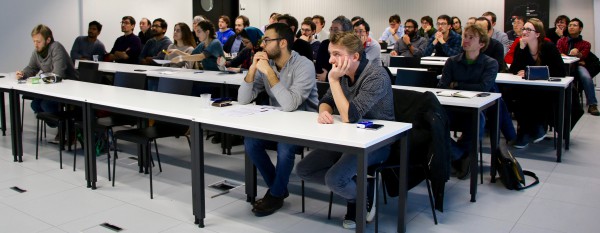MARVEL Junior Seminar — May 2024

Each seminar consists of two presentations of 25 minutes each, allowing to present on a scientific question in depth, followed by time for discussion. The discussion is facilitated and timed by the chair.
Pizzas will be served after the seminars in order to facilitate discussions based on the talks just presented.
Onsite participation
12:15 — Seminars take place in EPFL room Coviz2 (MED 2 1124)
~13:15 — Pizzas will be served in the MED building atrium, second floor
Online participation
Starting at 12:15:
https://epfl.zoom.us/j/68368776745
Password: 1923

Abstracts
Talk 1 — Machine-learning the transition state ensemble of chiral molecular interconversion on enantioselective substrates
Raymond C. Amador1, 2, Peilin Kang3, Enrico Trizio3,4, Marcella Iannuzzi5, Michele Parrinello3, Daniele Passerone1,2
1nanotech@surfaces, Empa, Dübendorf
2Dep. Informationstechnologie und Elektrotechnik, ETH Zürich
3Atomistic Simulations, Italian Institute of Technology, Genova, Italy
4Department of Materials Science, Università di Milano-Bicocca, Italy
5Department of Chemistry, University of Zürich, Zürich
Many important phenomena in the physical and biological sciences take place on time scales that are not directly accessible to microscopic simulations: phase transformations, chemical reactions and protein (un)folding are three broad classes of such processes. These processes are typically marked by high free energy barriers separating individual metastable states (the set of whose configurations constitutes the transition state ensemble (TSE)), and this renders the timescale of their occurrence on the order of nanosecond or longer. As such, these phenomena are referred to as rare events in the literature. The study of transformation from metastable state to metastable state is of great theoretical and practical importance, as therein lies the entire information on the reaction thermodynamics and rates.
In this talk, we apply for the first time to a DFT-modeled reaction a method recently introduced by Kang et. al. [1]. The methods use the committor function of Kolmogorov to study the TSE of the interconversion from the S to the R enantiomer of the DBBA precursor molecule as catalysed by the chiral intermetallic PdGa substrate. Enantioselective catalysis finds great interest in the modern chemical and pharmaceutical industries, since many biologically significant substances — amino acids and sugars being some of the most prominent — require enantiopure presence. Hereto, we have already shown the PdGa class of substrates to act as a promising catalyst in enantioselective reactions [2]. Our studies lay the groundwork of the Kolmogorov committor function to further investigate not only enantioselective catalysis, but rare event sampling and transition state theory in general.
[1] Kang, P., Trizio E., Parrinello M. arXiv:2401.05279 [physics.comp-ph
[2] Merino-Diez, N., Amador, R., Stolz, S. T., Passerone, D., Widmer, R., & Gröning, O. (2024), Advanced Science, 1-9. https://doi.org/10.1002/advs.202309081
Talk 2 — Vorticity and compressibility in viscous phonon fluids
Enrico Di Lucente1, Francesco Libbi2, Nicola Marzari1,3
1 Laboratory Theory and Simulation of Materials (THEOS) , EPFL
2 Harvard University, USA
3 Laboratory for Materials Simulations, PSI
Recent experiments have provided compelling evidence for the theoretical predictions of phonon hydrodynamics in graphene and other fast thermal conductors. In contrast to diffusive heat transport, this regime, similar to that of viscous fluids, is primarily governed by momentum-conserving phonon collisions. Here, we disentangle the steady-state viscous heat equations (VHE) - that are the thermal counterpart of the Navier-Stokes equations (NSE) in the laminar regime - in terms of modified biharmonic equations for the velocity potential and stream function of the phonon fluid. The resulting solutions can be merged into a complex potential defining the flow stramlines and give rise to two distinct temperature contributions intricately linked to the concepts of thermal compressibility and vorticity. Thus, we analytically solve the flow in a 2D strip device made of graphite, exploring the boundary conditions and transport coefficients needed to observe thermal vortices and negative thermal resistance, or heat backflow from cooler to warmer regions, and proposing a straightforward experimental apparatus to detect this distinctive hallmark of viscous transport. Last, we also examine the irrotational and incompressible limits of the phonon VHE, particularly showing how the latter represents the thermal analogue of the NSE for the electron fluid. This study provides analytical tools to engineer hydrodynamic phonon flow and uncover its connections with electron fluids. These implications could be pivotal for next-generation technologies, where, for instance, the sign-changing thermal response could be used to improve heat management in microdevices.
Check the list of the next MARVEL Junior Seminars here.
Low-volume newsletters, targeted to the scientific and industrial communities.
Subscribe to our newsletter